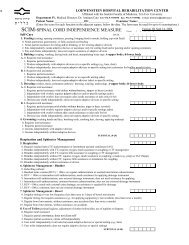HiMAT: HIGH LEVEL MOBILITY ASSESSMENT TOOL
HiMAT: HIGH LEVEL MOBILITY ASSESSMENT TOOL
HiMAT: HIGH LEVEL MOBILITY ASSESSMENT TOOL
Create successful ePaper yourself
Turn your PDF publications into a flip-book with our unique Google optimized e-Paper software.
<strong>HiMAT</strong>: <strong>HIGH</strong> <strong>LEVEL</strong> <strong>MOBILITY</strong> <strong>ASSESSMENT</strong> <strong>TOOL</strong><br />
DATE…………………………………<br />
DATE OF ACCIDENT………………<br />
DIAGNOSIS……………………..…..<br />
AFFECTED SIDE LEFT / RIGHT<br />
PATIENT<br />
ID<br />
LABEL<br />
SCORE<br />
ITEM PERFORMANCE 0 1 2 3 4 5<br />
WALK sec X > 6.6 5.4-6.6 4.3-5.3 < 4.3 X<br />
WALK BACKWARD sec >13.3 8.1-13.3 5.8-8.0 < 5.8 X<br />
WALK ON TOES sec > 8.9 7.0 - 8.9 5.4-6.9 < 5.4 X<br />
WALK OVER OBSTACLE sec > 7.1 5.4-7.1 4.5-5.3 < 4.5 X<br />
RUN sec > 2.7 2.0-2.7 1.7-1.9 < 1.7 X<br />
SKIP sec > 4.0 3.5-4.0 3.0-3.4 < 3.0 X<br />
HOP FORWARD (AFFECTED) sec > 7.0 5.3-7.0 4.1-5.2 < 4.1 X<br />
BOUND (AFFECTED) 1) cm<br />
2)<br />
3)<br />
BOUND (LESS-AFFECTED) 1) cm<br />
2)<br />
UP STAIRS DEPENDENT<br />
(Rail OR not reciprocal: if not,<br />
score 5 and rate below)<br />
UP STAIRS INDEPENDENT<br />
(No rail AND reciprocal: if not<br />
score 0 and rate above)<br />
DOWN STAIRS DEPENDENT<br />
(Rail OR not reciprocal: if not<br />
score 5 and rate below)<br />
3)<br />
< 80 80-103 104-132 > 132 X<br />
< 82 82-105 106-129 > 129 X<br />
sec >22.8 14.6-22.8 12.3-14.5 9.1 7.6-9.1 6.8-7.5 < 6.8 X<br />
sec >24.3 17.6-24.3 12.8-17.5 8.4 6.6-8.4 5.8-6.5 < 5.8 X<br />
TOTAL <strong>HiMAT</strong> SCORE /54<br />
Please notify Gavin Williams at gavin@neuro-solutions.net or gavin.williams@epworth.org.au so that<br />
the use of the <strong>HiMAT</strong> can be tracked.
<strong>HiMAT</strong>: High-level Mobility Assessment Tool<br />
Instructions<br />
Subject suitability: The <strong>HiMAT</strong> is appropriate for assessing people with high-level balance and<br />
mobility problems. The minimal mobility requirement for testing is<br />
independent walking over 20m without gait aids. Orthoses are permitted.<br />
Item testing:<br />
Instructions:<br />
Walking:<br />
Walk backward:<br />
Walk on toes:<br />
Walk over obstacle:<br />
Run:<br />
Skipping:<br />
Hop forward:<br />
Bound (affected).<br />
Bound (less-affected).<br />
Up stairs:<br />
Down stairs:<br />
Scoring:<br />
Testing takes 5-10 minutes. Patients are allowed 1 practice trial for each item.<br />
Patients are instructed to perform at their maximum safe speed except for the<br />
bounding and stair items.<br />
The middle 10m of a 20m trial is timed.<br />
As for walking.<br />
As for walking. Any heel contact during the middle 10m is recorded as a fail.<br />
As for walking. A house brick is placed across the walkway at the mid-point. Patients must<br />
step over the brick without contacting it. A fail is recorded if patients step around the brick or<br />
make contact with the brick.<br />
The middle 10m of a 20m trial is timed. A fail is recorded if patients fail to have a consistent<br />
flight phase during the trial.<br />
The middle 10m of a 20m trial is timed. A fail is recorded if patients fail to have a consistent<br />
flight phase during the trial.<br />
Patients stand on their more affected leg and hop forward. The time to hop10m meters is<br />
recorded.<br />
A bound is a jump from one leg to the other with a flight phase. Patients stand behind a line<br />
on their less affected leg, hands on hips, and jump forward landing on their more affected<br />
leg. Each bound is measured from the line to the heel of the landing leg. The average of three<br />
trials is recorded.<br />
Patients stand behind a line on their more affected leg, hands on hips, and jump forward<br />
landing on their less affected leg. The average of three trials is recorded.<br />
Patients are asked to walk up a flight of 14 stairs as they normally would and at their normal<br />
speed. The trial is recorded from when the patient starts until both feet are at the top. Patients<br />
who use a rail or a non-reciprocal pattern are scored on Up Stairs Dependent. Patients who<br />
ascend the stairs reciprocally without a rail are scored on Up Stairs Independent and get an<br />
additional 5 points in the last column of Up Stairs Dependent.<br />
As for Up stairs.<br />
All times and distances are recorded in the ‘performance’ column. The<br />
corresponding score for each item is then circled and each column is then<br />
subtotaled. Subtotals are then added to calculate the <strong>HiMAT</strong> score.



